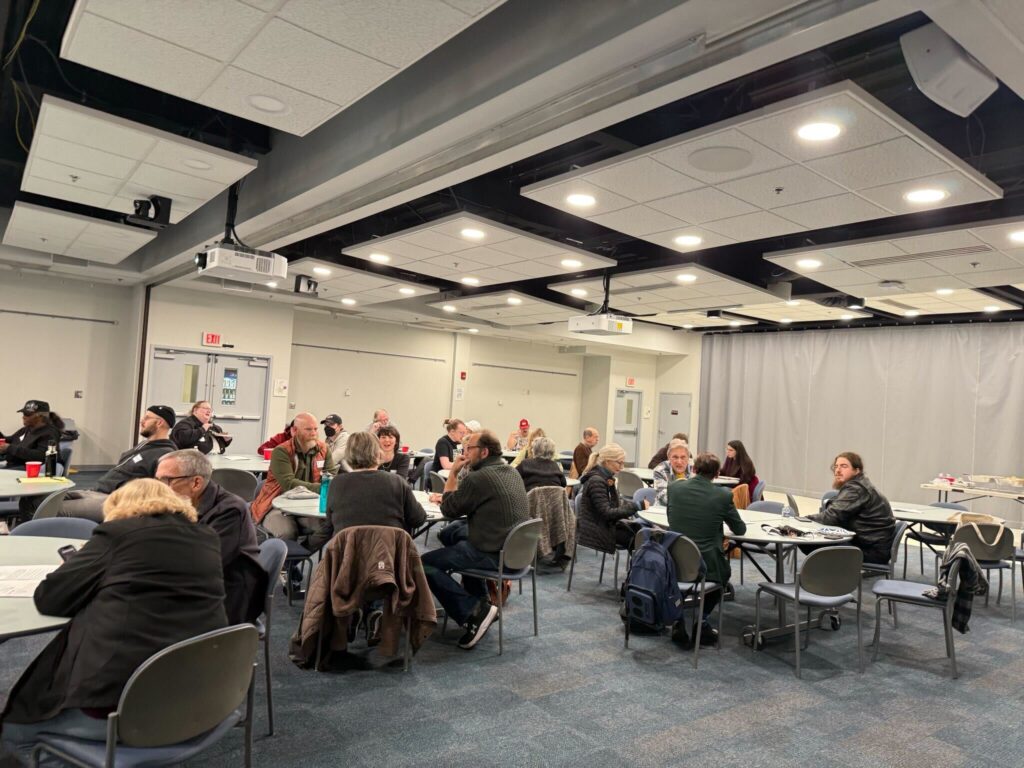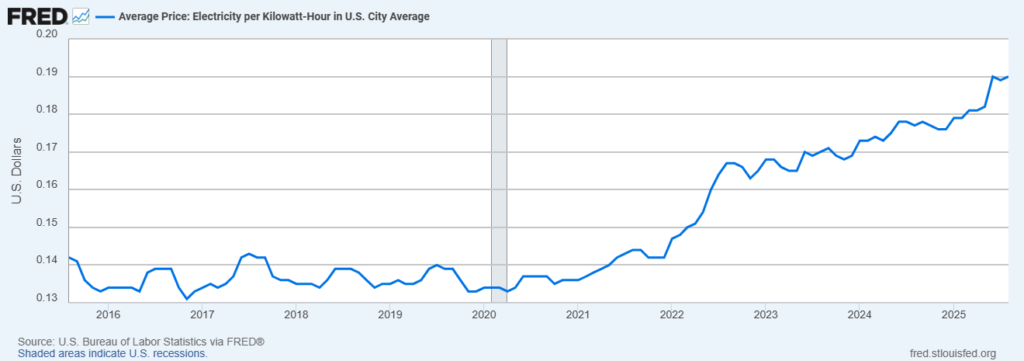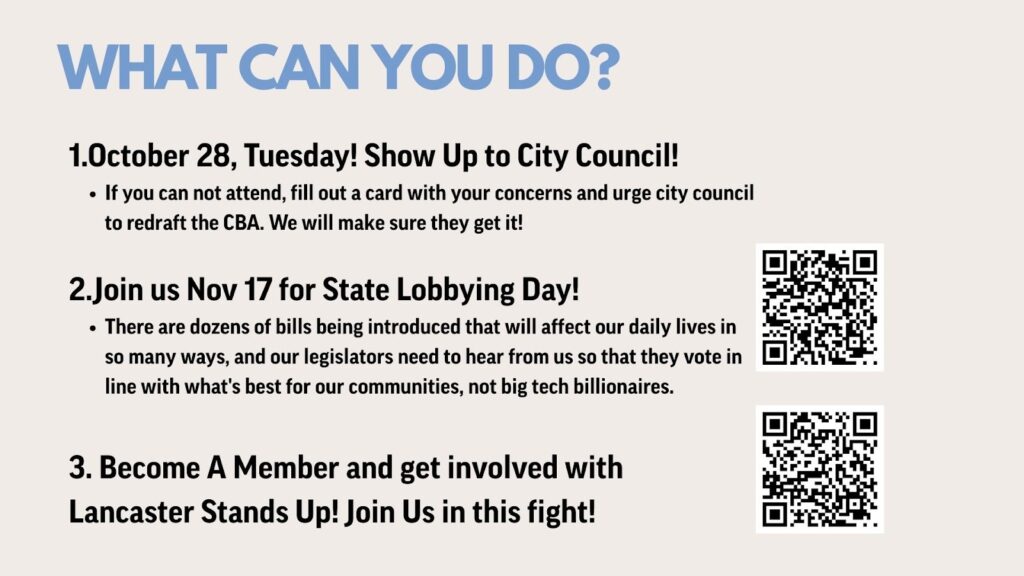
Friends, if you have not already heard (either from our emails, or the news), there are two proposed data centers within Lancaster. Our organization is actively fighting back against big tech’s intrusion in our community, and we were proud to hold a community conversation this past Thursday at Harrisburg Area Community College to address the issue.
Our conversation was wide-ranging, touching on municipal zoning regulations and environmental impacts. The most important thing? The community appreciated the conversation, and we all left feeling more empowered as we continue on this journey together as a community.
If you managed to attend our conversation, we graciously thank you for your attendance! And if you didn’t manage to attend, don’t worry, there are still ways for you to get involved!
What we talked about
- The zoning process that allowed the data centers to be approved
- The environmental impacts of data centers
- The financial (non)benefits of the data center
- Frank Arcoleo’s appeal
- Community Benefits Agreement
- What we can do
There are two proposed data centers in Lancaster. The first is at 216 Greenfield Road. Phase 1 is currently underway, and permits have been submitted for the larger Phase 2 facility. The second data center is at 1375 Harrisburg Pike, with a permit expected soon for development to begin.
It is clear that Lancaster residents will not be on the receiving end of any benefits this data center offers. Rather, it will bring us dirtier drinking water, higher electricity costs, a strained electrical grid, and noise pollution.
If you were to stack up these negatives against the supposed benefits these data centers theoretically bring, it would still be unwelcome in our community.
The truth is that this data center was approved without accountability, using a process that is clearly outdated to designate it as a warehouse, and without a single notice to the community prior to the agreement.
That’s not how we should operate in Lancaster.
Data centers are not warehouses; they are a digital infrastructure that relies on vast amounts of water, electricity, and GPUs to power them. They don’t simply house computer parts, they are actively powering digital applications. They are processing plants not warehouses. And they are not welcome here.
The Zoning Appeal
Lancaster Stands Up’s own Frank Arcoleo filed an appeal regarding the zoning determination that allowed the construction of the data centers. At the moment this remains our best chance to either stop the projects entirely, or force them to undergo the standard zoning process. This legal process is determined by the city’s Zoning Hearing Board. However, it has since been paused due to a legal challenge from the developer. Keep tuned for updates.
If the process was legitimate, and the city’s determination foundationally solid, why spend the money on a drawn out legal battle?
While the appeal itself is on hold, our community’s battle is not. Lancaster’s City Council has responded to community concerns aiming for a new zoning law.
New Zoning Law
A proposed law would add a new category for data centers. A draft was introduced on October 6, with adoption expected in December. We find ourselves in a gray area as to what extent (if any) this new law will apply to the existing projects at Greenfield Road and Harrisburg Pike.
Here’s what you need to know about the new law. A plan/report is required before approval. On energy use, it requires “good faith efforts” on clean energy. In terms of noise, we have again shied away from using a strict decibel level. As it stands, the existing noise ordinance rules supreme. Air quality will require annual testing to ensure compliance. And on water, e-waste, and heat mitigation, only plans are required, meaning there are no teeth to back anything up.
The city has made a step in the right direction, but we believe that more can be done. The noise ordinance needs to be updated to regulate industrial noise pollution. It lacks any decommissioning requirements and fails to force developers to put forward sustainable and environmentally conscious plans.
So what even is this data center?
Developer Chirisa Technology Parks and Machine Investment group have partnered with Corweave to build these data centers. They are being constructed by local construction firm Wohlson with the owner being LPE O1 Propco LLC (which was formerly Machine Investment Group). These data centers are labelled as hyperscale data centers.
A hyperscale data center can use over 100+ megawatts of power. To put that into perspective, that’s enough to power all the homes in Lancaster City three times.
This kind of data center uses thousands of servers as power for complicated, multi-step tasks. Think of it as a lake of data: you tell the data center what you are looking for and what you want to do with it. It then goes fishing into the lake to retrieve anything helpful. The larger the request, the more work it has to put in.
When you use that much electricity you have to take care of the heat generated. This can be done using air cooling, or water cooling. Both of these are inefficient, and to manage that amount of heat, we’re talking an incredible amount of electricity usage. To the point where data centers are now the leading cause for the increase in energy costs.
Imagine adding 100,000 new homes to the electrical grid.

This particular data center will be using diesel generators, and the developers have signed a community benefits agreement committing to not use water cooling. Let’s talk about that CBA.
The Community Benefits Agreement
A community benefits agreement (CBA) is a legally binding agreement between the developer and the community. The CBA in this case was negotiated by the mayor, and there is currently a draft available. The language is unclear regarding certain provisions such as noise, and the priorities identified were not addressed in performance commitments.
There is a hard cap of 20,000 gallons of water per day per property. This is on the extreme low end as data centers can sometimes use up to 5 million. Anything more than this amount requires a permit from the Susquehanna River Basin Commission.
The CBA is also an attempt to claim that the data centers will not currently add to the noise level. If true, that would be great, however, the CBA does not fully address what that means. Instead splitting the noise level requirements for day and night as the lowest acceptable at that time. The language is not only confusing, but provides no context and no real metric for accountability.
As it stands, there is no benefit to the community with this CBA, as it fails to have enforcement mechanisms and clear consequences for breaking the agreement, using vague language such as “when feasible”. Seriously? The environmental wellbeing of our community is being placed at risk but we want them to mitigate those risks when it benefits them?
We expect more out of a CBA involving something like this. We don’t just want simple mitigation measures. The language of the CBA screams that this data center will be harmful. A CBA should provide tangible benefits to the community: such as commitments to housing projects, green energy initiatives, and investments within the community.
There is no decommissioning plan, no insurance plan, and no assurance that we will not be saddled with these buildings when it no longer becomes economically justifiable for the developers to operate them.
We win locally
Right now, many municipalities within Pennsylvania as a whole – not just Lancaster County – are not prepared for the wave of data center construction. Within our own county we are prepared to work with all municipalities to ensure they have protections in place to mitigate and deter harmful construction that can have damaging lasting environmental impacts. While elected officials have seemed afraid to speak up about this, people like us have not been so timid.
This means we have to meet our officials at city and borough council meetings. We must be prepared to organize purposeful collective action. What needs to change are our communities’ commitment to the wellbeing of their residents. This means changing zoning ordinances, updating planning, and considering a reclassification of industrial uses.
We stand ready to work with all elected officials to solve problems. But we also stand ready to call them out when their integrity falls short.
Yes, President Trump, Governor Shapiro, Senator McCormick, and Mayor Sorace are all in favor of big tech’s data center intrusions. Shapiro was proud to announce a $20 billion Amazon data center agreement which included tax breaks. But all is not lost. Communities around the United States have taken on big tech, and they’ve won.
We will, too.
If you’re interested in joining us in this fight we have some things coming up!
